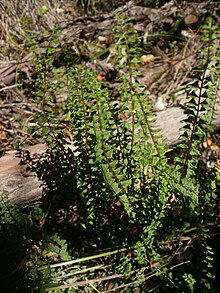Lindsaeaceae
| Lindsaeaceae Temporal range: | |
|---|---|

| |
| Lindsaea linearis | |
| Scientific classification | |
| Kingdom: | Plantae |
| Clade: | Tracheophytes |
| Division: | Polypodiophyta |
| Class: | Polypodiopsida |
| Order: | Polypodiales |
| Suborder: | Lindsaeineae |
| Family: | Lindsaeaceae C.Presl ex M.R.Schomb.[1] |
| Genera | |
|
See text | |
Lindsaeaceae is a pantropical family of ferns in the order Polypodiales. It contains six or seven genera with about 220 known species,[2] some of which also extend into the more temperate regions of eastern Asia, New Zealand, and South America.[3]
Description
Characteristics include: Rhizomes short to long creeping; rhizomes with nonclathrate scales or uniseriate hairs; blades 1-3 pinnate or more divided; veins usually free; sori marginal or submarginal; indusia open towards margin, sometimes attached at sides, or sori covered by the reflexed segment margin.[4]
Taxonomy
For more than a century, these ferns were considered part of the Davalliaceae. Then starting in the mid-twentieth century they began to be transferred to the Dennstaedtiaceae. Molecular data supported the separation of Lindsaeaceae into its own family, which was proposed in 1970.[3] Lindsaeaceae is considered among the most basal of the families in the order Polypodiales. One hypothesis for the relationships within the order is shown in the following cladogram:[5]
| Polypodiales |
| ||||||||||||||||||||||||
The genus Lonchitis has many morphological characteristics similar to Dennstaedtiaceae, but a few characteristics of the spore are similar to the lindsaeoid genera, and molecular data placed this genus in Lindsaeaceae.[6] It is now placed in the related family Lonchitidaceae.[7]
Genera
| Phylogeny of Lindsaeaceae[8][9] |
The Pteridophyte Phylogeny Group classification of 2016 (PPG I) recognized seven genera.[5]
- Lindsaea Dryand. ex Sm. (about 180 species)
- × Lindsaeosoria Wagner (1 species)
- Nesolindsaea Lehtonen & Christenh. (2 species)
- Odontosoria Fée (about 23 species)
- Osmolindsaea (K.U.Kramer) Lehtonen & Christenh. (about 7 species)
- Sphenomeris Maxon (3 species)
- Tapeinidium (C.Presl) C.Chr. (18 species)
- Xyropteris K.U.Kramer (1 species)
Other sources retain Xyropteris in Lindsaea.[10]
The extinct genus Proodontosoria from the Cenomanian aged Burmese amber of Myanmar has been assigned to the family.[11] Other fossil remains assigned to the family include an indeterminate leaf fragment also from the Burmese amber,[12] as well as a permineralized root from the Albian aged Aspen Shale of Wyoming.[13]
Other genera that have been placed in the Lindsaeaceae are:[7]
- Lonchitis L. – transferred to its own family Lonchitidaceae
- Saccoloma Kaulf. – transferred to its own family Saccolomataceae
- Cystodium J.Sm. – transferred to its own family Cystodiaceae
References
- ^ Lindsaeaceae C. Presl ex M.R. Schomb. Tropicos.org. Missouri Botanical Garden. 01 Feb 2012
- ^ Christenhusz, M. J. M. & Byng, J. W. (2016). "The number of known plants species in the world and its annual increase". Phytotaxa. 261 (3). Magnolia Press: 201–217. doi:10.11646/phytotaxa.261.3.1.
- ^ a b Lehtonen et al.: Phylogenetics and classification of the pantropical fern family Lindsaeaceae[permanent dead link] in the Botanical Journal of the Linnaen Society 2010
- ^ Smith, A. R., K. M. Pryer, et al. (2006). "A classification for extant ferns." Taxon 55(3): 705-731
- ^ a b PPG I (2016). "A community-derived classification for extant lycophytes and ferns". Journal of Systematics and Evolution. 54 (6): 563–603. doi:10.1111/jse.12229. S2CID 39980610.
- ^ Wolf, P. G. (1997). "Evaluation of atpB Nucleotide Sequences for Phylogenetic Studies of Ferns and Other Pteridophytes." American Journal of Botany 84(10): 1429-1440
- ^ a b Christenhusz et al. "A linear sequence of extant families and genera of lycophytes and ferns" Phytotaxa 19: 7-54. 18 Feb. 2011
- ^ Nitta, Joel H.; Schuettpelz, Eric; Ramírez-Barahona, Santiago; Iwasaki, Wataru; et al. (2022). "An Open and Continuously Updated Fern Tree of Life". Frontiers in Plant Science. 13: 909768. doi:10.3389/fpls.2022.909768. PMC 9449725. PMID 36092417.
- ^ "Tree viewer: interactive visualization of FTOL". FTOL v1.3.0. 2022. Retrieved 12 December 2022.
- ^ "Xyropteris K.U.Kramer". Plants of the World Online. Royal Botanic Gardens, Kew. Retrieved 2019-11-17.
- ^ Li, Chunxiang; Moran, Robbin C.; Ma, Junye; Wang, Bo; Hao, Jiasheng (January 2020). "A new fossil record of Lindsaeaceae (Polypodiales) from the mid-Cretaceous amber of Myanmar". Cretaceous Research. 105: 104040. doi:10.1016/j.cretres.2018.12.010. S2CID 134602978.
- ^ Regalado, Ledis; Schmidt, Alexander R.; Müller, Patrick; Kobbert, Max J.; Schneider, Harald; Heinrichs, Jochen (April 2017). "The first fossil of Lindsaeaceae (Polypodiales) from the Cretaceous amber forest of Myanmar". Cretaceous Research. 72: 8–12. doi:10.1016/j.cretres.2016.12.003.
- ^ Schneider, Harald; Kenrick, Paul (May 2001). "An Early Cretaceous root-climbing epiphyte (Lindsaeaceae) and its significance for calibrating the diversification of polypodiaceous ferns". Review of Palaeobotany and Palynology. 115 (1–2): 33–41. doi:10.1016/S0034-6667(01)00048-3. PMID 11425346.
